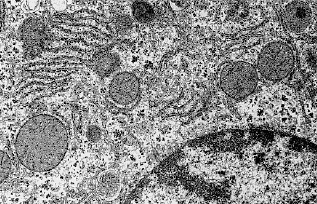|
Eukaryotes: the origin of complex cells
The eucaryotic cell originated from a symbiosis of several bacterial species.
|
 Eukaryotes are complex, nucleated cells, that contain internal organelles (e.g. mitochondria, lysozomes, centrioles and chloroplasts), specialized "organs" that often contain their own DNA. They thus distinguish themselves from the much smaller and simpler Eukaryotes are complex, nucleated cells, that contain internal organelles (e.g. mitochondria, lysozomes, centrioles and chloroplasts), specialized "organs" that often contain their own DNA. They thus distinguish themselves from the much smaller and simpler  prokaryotes, cells without internal structure. Bacteria are prokaryotes, while protozoans, like the Amoeba, and the cells of fungi, plants and animals are eukaryotes. According to the prokaryotes, cells without internal structure. Bacteria are prokaryotes, while protozoans, like the Amoeba, and the cells of fungi, plants and animals are eukaryotes. According to the  endosymbiotic theory of Lynn Margulis, organelles originated as smaller bacteria-like cells that were engulfed by a larger cell and continued to live inside that cell, using its products while producing some other products in return. Thus, these bacteria lived in internal symbiosis (endosymbiosis) with the encompassing cell. Mitochondria are bacteria that became specialized as energy producers. endosymbiotic theory of Lynn Margulis, organelles originated as smaller bacteria-like cells that were engulfed by a larger cell and continued to live inside that cell, using its products while producing some other products in return. Thus, these bacteria lived in internal symbiosis (endosymbiosis) with the encompassing cell. Mitochondria are bacteria that became specialized as energy producers.

This is a transmission electron micrograph of rat liver cells. Part of the nucleus is in the right lower corner. Circular objects are mitochondria.
Copyright© 1998 Principia Cybernetica -
Referencing this page
|
|
|

